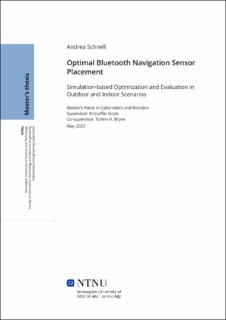| dc.contributor.advisor | Gryte, Kristoffer | |
| dc.contributor.advisor | Bryne, Torleiv H. | |
| dc.contributor.author | Schnell, Andrea | |
| dc.date.accessioned | 2023-09-29T17:22:08Z | |
| dc.date.available | 2023-09-29T17:22:08Z | |
| dc.date.issued | 2023 | |
| dc.identifier | no.ntnu:inspera:140443607:35327930 | |
| dc.identifier.uri | https://hdl.handle.net/11250/3093206 | |
| dc.description.abstract | I løpet av de siste årene har det vært en utvikling innen teknologi som har forårsaket et behov for økende evne til å navigere i ulike miljøer. De velkjente og velbrukte Global Navigation Satellite Systems (GNSS) gir tilstrekkelig navigasjonsnøyaktighet i mange tilfeller, men de er begrenset til navigasjon utendørs og med nøyaktighet på meternivå. Nye metoder som har mulighet til å gi robust nav igasjon med en nøyaktighet på under en meter, både innendørs og utendørs, er gunstig å utforske.
Denne oppgaven utforsker mulighetene for å bruke ulike Bluetooth-sensorer for navigasjon. Bluetooth Low Energy (BLE) har to måter oppnå posisjonsinformasjon på, enten ved å finne retningen (Direction Finding) eller distansen (beacon range). Avhandlingen har som mål å demonstrere hvordan Bluetooth-sensorer kan brukes til å gi robuste navigasjonsløsninger ved å utføre to analyser: ett utendørs og det andre innendørs. Utendørsscenarioet tar for seg en Unmanned Aerial Vehicle (UAV) som trenger navigering når den flyr mot et landingsnett. Navigasjonen utføres ved å estimere UAV-ens tilstand med et Extended Kalman Filter (EKF), deretter evalueres den mulige nøyaktigheten ved å bruke Cramér-Rao Lower Bound (CRLB) metoden. Det andre scenarioet forestiller et autonomt lager-scenario, som krever konstant overvåking av roboter i bevegelse. For å klassifisere den oppnådde dekningen av Bluetooth-sensorene, brukes en maksimal sannsynlighetsestimator for å evaluere hvor godt hvert punkt på lageret er dekket av sensorer. CRLB brukes også i dette tilfellet for å vurdere nøyaktigheten av metoden.
Målet med oppgaven er å gi en mer grundig forståelse av hvordan Bluetoothenheter kan utnyttes til navigering. Fokuset er på å optimalisere sensorposisjonene for ideell geometri for å begrense antall sensorer som trengs. Bluetooth-enheter er enkle å bruke og rimelige, men kommunikasjonsmetoden er ved bruk av radiofrekvenssignaler (RF) som gjør dem utsatt for diverse feil og støy. Resultatene i denne oppgaven demonstrerte imidlertid hvordan det er mulig å oppnå nøyaktig navigasjon samtidig som det forblir et lavkostsystem. Konklusjonen er at det er mulig å implementere et navigasjonssystem med Bluetooth-enheter med hensyn til ønsket bruk. Nødvendig nøyaktighet kan oppnås dersom man er villig til å investere i utstyr. | |
| dc.description.abstract | Over the last few years, there has been an evolution in technology that has caused a demand for increasing abilities to navigate in various environments. The well-known, and widely used, Global Navigation Satellite Systems (GNSS) provide adequate navigation accuracy, but they are limited to navigation outdoors and with meter-level accuracy. New methods that can provide robust navigation with a sub-meter level accuracy indoors and outdoors are advantageous to explore.
This thesis explores the possibilities of utilizing various Bluetooth Low Energy (BLE) sensors for navigation. BLE has two ways of positioning: Direction Finding or beacons for distancing. The thesis demonstrates how Bluetooth sensors can be used to provide viable navigation solutions when GNSS are not available by simulating two scenarios: one situated outdoors and the other indoors. The outdoor scenario considers an Unmanned Aerial Vehicle (UAV) that needs navigation when flying toward a landing net. The navigation is performed by estimating the UAV’s state with an Extended Kalman Filter (EKF), then the achievable precision is evaluated using the Cramér-Rao Lower Bound (CRLB) method. The other scenario mimics an autonomous warehouse scenario, requiring constant monitoring of moving robots. To classify the obtained coverage by the Bluetooth sensors, a maximum likelihood estimator is used to evaluate how well every point in the warehouse is covered. The CRLB is also applied in this case to assess the method.
Throughout the thesis, a more thorough understanding of how Bluetooth devices can be used for navigational purposes is provided, with a special focus on the optimization of sensor positions for ideal geometry to limit the number of sensors needed. Bluetooth devices are easy to deploy and low-cost. However, BLE communicates with radio frequency (RF) signals which makes them prone to errors and noises. However, the results provided in this thesis demonstrated how it is possible to obtain accurate navigation while remaining a low-cost system. The conclusion is that it is possible to implement a navigation system with Bluetooth devices with respect to the wanted use case. The necessary accuracy can be achieved if one is willing to invest in equipment | |
| dc.language | eng | |
| dc.publisher | NTNU | |
| dc.title | Optimal Bluetooth Navigation Sensor Placement | |
| dc.type | Master thesis | |
